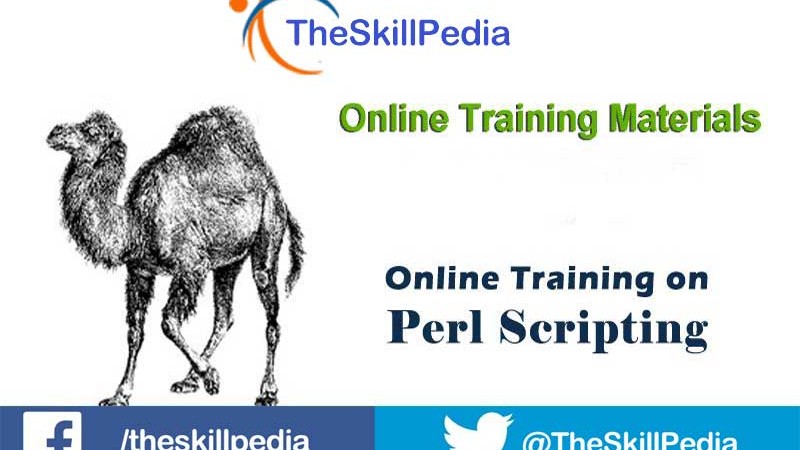PERL Scripting Training - Join Now
Introduction to
PERL Scripting Training
- Introduction to PERL Scripting Training Course.
- Origin and Design Goals of Perl.
- Overview of Perl Features.
- Getting and Installing Perl.
- Accessing Documentation via perldoc.
- HTML-Format Reference Documentation.
- Perl Strengths and Limitations.
Getting Started With Perl
- Explicit Invocation of the Perl Interpreter
- Running Perl on UNIX vs. Windows
- Running Perl from the Command Line
- Using Command Line Options
- Using Debug Mode
- Implicit Invocation of the Perl Interpreter
- Running and Debugging Perl Scripts
- Simple and Compound Statements
- Fundamental Input Techniques
- Using the print Function to Generate Standard Output
Using Variables - Watch Lecture Online
- Scalar Variables
- Introduction to Standard Data Types
- Retrieving Standard Input Using the Default Variable $_
- Reserved Scalar Variables
- Assigning Strings and Numbers to Scalar Variables
- Declaring Constants for Persistent Values
- Using strict to Declare Variables
- Introduction to Fundamental Operators
- Operator Precedence and Associativity
- Using the Ternary Operator ?: as a Shortcut for the if Statement
- Using and <> File I/O Operators for Standard Input/Output
- Using the Shortcut Operators +=, -=, *=, /=
Flow Control: Conditional Statements and Looping
- Conditional Expressions and Logical Operators
- if/else/elsif and unless
- Constructing switch/case Equivalent Expressions
- while Loops and do Loops
- for and foreach Loops
- Labels
- Altering Program Flow with next, last, and redo
- Trapping Errors with the eval Function
- Terminating a Script with exit
- Regular Expressions in Perl
- Using Pattern Matching Operators
- Altering Data with Substitutions in Regular Expressions
- Using Backreferences to Capture Data from Regular Expression Matching
- Global and Case-Insensitive Matches
- Altering Data with Character Translation
- Using Variables in Patterns
String Manipulation
- String Comparison
- String Relations
- Concatenation
- Substring Manipulation
- Using chomp and chop to Eliminate EOL Characters
- Escape Characters for Formatting
- String Manipulation Functions
- Simplifying Scripts with Subroutines
- Defining and Calling a Subroutine
- Passing Arguments by Value
- Passing Arguments by Reference
- Using return to Return a Value
- Controlling Variable Scope using myand local Keywords
File and Directory I/O
- Using open and close
- File Open Modes
- Reading Files into Arrays
- Retrieving File Metadata
- Built-in File Management Functions
- Using print and write
- File Test Operators
- Directory Manipulation Using opendir, closedir, readdir, chdir, mkdir andrmdir
Implementing Command Line Arguments
- Reading Command Line Arguments from @ARGV
- Read Files Explicitly with and Implicitly with <>
- Manipulating Positional Parameters with push, pop, shift
- Process Lists of Files
- Processing Command Line Options with getopt or getopts
- Analyzing Command Line Argument Values with the Getopt::Std andGetopt::Long Modules
- Reserved Variables
- Manipulating Identifiable Options UsingGetOptions
Debugging In Perl
- Using the Built-in Perl Debugger
- Starting the Debugger
- Debugger Command Syntax
- Checking for Script Syntax Errors
- Solving Compile-Time Errors
- Single-Stepping through a Script
- Executing to Breakpoints
- Setting Global Watches
- Printing Values of Variables
- Listing All Variables Used in the Script
- Using Strict Error Checking
- Quitting the Debugger
Packages and Modules
- The Power of Packages and Modules
- Introduction to Standard Modules
- Where to Find Modules on the Internet
- Installing a Module on UNIX or Windows
- Creating Packages for Portability
- Using Packages to Create Isolated Namespaces and to Separate Code
- Creating Modules
- Creating and Using Symbols in a Module
- Using the Exporter to Export Symbols from a Perl Module
Input/Output Processing
- Parsing Input
- Using Standard Input, Standard Output, and Standard Error
- String and Field Processing
- Using Streams and Pipes
- Using die to Quit with an Error
- Redirecting Standard Output and Standard Error to a File
- Getting Standard Input from a File
Perl Report Formatting
- Defining Report Formats
- Justifying Text (Left, Right, Center)
- Using write to Generate Reports
- Defining here Documents for Report Customization
- Creating Report Headers
- Using Built-in Variables to Control Report Appearance
- Printing Line Numbers on a Report
- Formatting Multi-Line Output
- Writing Formatted Text to a File
